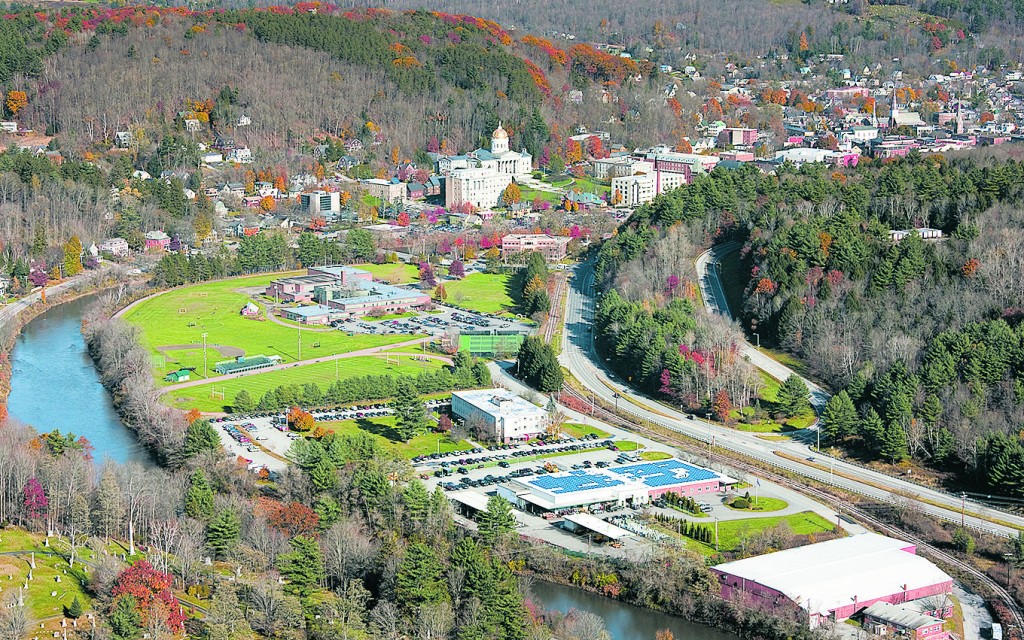Net-zero Capital’s Goal in Sight

Green Mountain Power’s solar roof array installed by Alteris Renewables. © 2010 Neil Dixon
By Dan Jones
It has now been a year since Montpelier City Council unanimously committed to becoming “net zero” in fossil fuel use by 2030. This big goal – meeting all the city and its residents’ energy needs through renewable supplies in 15 years – is imperative. It is also aggressively ambitious and, frankly, seems bigger and more challenging as the city goes about those actions needed to accomplish it.
Committing a city government to a course of action is one thing, but it is quite another to commit the entire community to partnering with you on that effort. That said, we need some kind of whole-community approach across all towns and cities, in Vermont and beyond. This requires, however, a re-imagining and realigning of how people use and generate energy — not a simple undertaking by any means, but a commitment to a healthy future local economy. The money we currently send out of town for oil and gas will, instead, create local jobs which will in turn depend on local workers, not global corporations. As we move more deeply into this effort our little city’s current challenge is to figure out how to mobilize our diverse community – everyone – in a really long-term push towards getting people off of dirty, dwindling fossil fuels.
The City of Montpelier, largely under the leadership of the volunteer Montpelier Energy Advisory Committee (MEAC) is engaged in a multi-pronged effort. It is attempting to mobilize resources, inspire behavior change and motivate Montpelier-ites to invest in fossil fuel-reducing solutions to meet our ambitious goal. MEAC has divided our strategies into different areas of energy use: heating, electric generation and transportation. We are even tentatively exploring a much more difficult issue of how possibly to transform our housing density, since dense, walkable cities are much more energy-efficient.
We have done a lot – but we have much more to do. And, we have a track record upon which to build, as this journey didn’t start last year. It started over a decade ago with the concept of a district heating plant. It grew through the effort of our local energy teams, who knocked on doors promoting energy efficiency, and surveyed city buildings and businesses for efficiency modifications.
In 2010, after the successful procurement of a DOE grant to support a local biomass district heat system, our energy advisory committee was mandated by the city council to oversee the process.
The district heat system will replace about 300,000 gallons of oil per year, which now costs almost a million dollars. Using regionally-sourced wood chips along with local maintenance services, the project is also keeping dollars working locally. I am proud to report that this innovative project started delivering heat to state and city offices and to some downtown businesses in fall of 2014. Reports of our initial customers are glowing in terms of its reliability and realized savings.
There are other efforts afoot, too. Montpelier is now completing negotiations with a local solar energy developer to provide 1 MW of net-metered electric generation which will cover over 70% of the city’s electric consumption, likely at a 15% savings under the utility tariff. The Montpelier schools are about to issue an RFP for enough solar generation to cover their needs. Our street lights are now LEDs. Even our sewage treatment plant has become a model of energy efficiency. This means that, except for city buses and vehicles, we are in sight of achieving our net-zero goals, at least for our municipal operations.
As we have matured and accomplished more, people from around the state have noted how lucky we are to have this committee, composed of knowledgeable and committed volunteers helping to build a resilient future for us all.
City and local leadership and the hard work of a dynamic, knowledgeable and committed cadre of volunteers, have been essential. But, again, there is much more to do.
Getting homes and apartment houses in the efficiency mix is somewhat harder. Since 2006, according to Efficiency Vermont, over 500 Montpelier homes (that’s 15%) have completed some level of weatherization work. Our energy committee is now in an intensive strategic planning effort to address the big energy demands of residential users and the whole transportation mix. For all of us, this work is the hardest because there are few easy, convenient alternatives.
Our big advantages going forward will be our small size. At 8,000 people we are able to move more quickly than larger political institutions, and there is an obvious benefit to being the capitol city of Vermont. Our population doubles mid-day, which brings vibrancy and resources to our local economy. Our very healthy commercial sector is quite supportive of the energy work, especially the savings now being realized from the district heat plant.
Montpelier is also gaining in other ways from our commitment to become net zero. Recently the Department of Energy and the White House recognized our city as one of 16 Climate Action Cities in the country. This will give us a leg up in mobilizing Federal resources. We are also one of the nation’s 50 finalist competitors for the Georgetown University Energy Prize.
We can boast many tangible results for a small city with such a forward looking commitment. There is much more real, hard work to do. But, if the next few years manifest anything close to the progress we have made to date, I believe it is quite possible for capitol of Vermont to be net-zero by 2030.
There is so much happening in Montpelier. Stay tuned for updates in future issues of Green Energy Times – as this city becomes the first fossil-fuel-free, net-zero capital in the country.
Dan Jones is the former chair of the Montpelier Energy Advisory Committee.








Leave a Reply